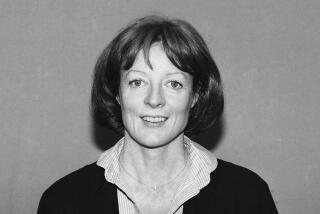AN APPRECIATION : Ashcroft’s Work Reflects Inner Grace
- Share via
The death of Dame Peggy Ashcroft on Friday brought us a step closer to the end of a century of a certain kind of acting: The hard-won kind we can’t forget. Not because Ashcroft was British or could round her vowels and articulate consonants, but because she imbued everything she did with a certain inner luminosity.
Such words can have a hollow ring when you can no longer witness the event, but during years that started early in the 1930s and spanned the better part of this difficult century, Ashcroft’s stature grew in the only valid sense: by virtue not of mere versatility (the acrobatics of acting) but of increasing moral scope that is a reflection of the inner self.
Gravity and grace permeated her work. These cannot be taught, only acquired. In Ashcroft’s case it was a quickness and serenity at the center of life, and an absence of visible ego, that transcended the actor to invade her creations.
That is what everyone subliminally remembers--and will miss most--about Ashcroft. But it is perhaps emblematic of a larger loss: the gradual disappearance of an uncommon generation of theater artists--among them Laurence Olivier, Ralph Richardson, Edith Evans--who were able to enlarge their characters with their own spiritual dimensions. Simplicity. Clarity. Sincerity. In the United States, Julie Harris comes closest to possessing this quality of inner radiance. In France, it is Jean-Louis Barrault. “Acting,” he said once, “is the science of man. An actor is an athlete of affectivity. Show me how you walk and I’ll tell you who you are.”
Like Barrault, Ashcroft possessed not selflessness, but humility. Acting was just something she did. She shunned offstage exposure to the public glare. She resisted interviews and, if persuaded to do one, would not discuss her private life. Privacy was paramount. In a celebrity-driven age, the trappings of celebrity did not interest her at all.
So it is mildly ironic that, only when the stage had become physically a bit too taxing for her, did she achieve worldwide recognition with David Lean’s film “A Passage to India” (in which she played the enigmatic Mrs. Moore and for which she won an Oscar) and on television with her role as a conflicted former missionary in “The Jewel in the Crown.” But it was fortunate irony.
Without it, she might have died known only to a relatively small and diminishing portion of the theatergoing public as a woman who loved acting for the sake of doing it well, and without pretension.
A fine epitaph, that reaches farther now that more of us have had the chance to see for ourselves.
More to Read
The biggest entertainment stories
Get our big stories about Hollywood, film, television, music, arts, culture and more right in your inbox as soon as they publish.
You may occasionally receive promotional content from the Los Angeles Times.










